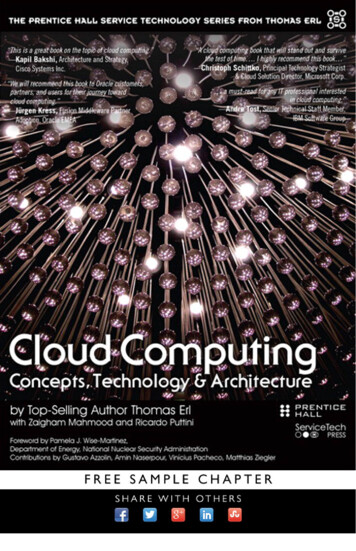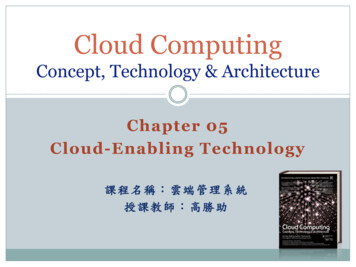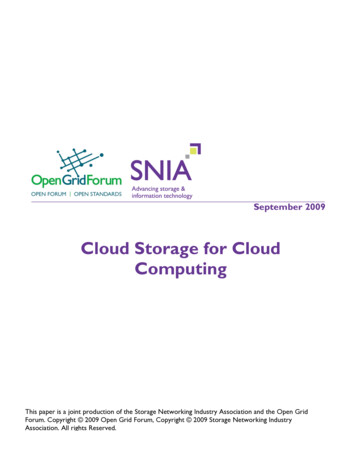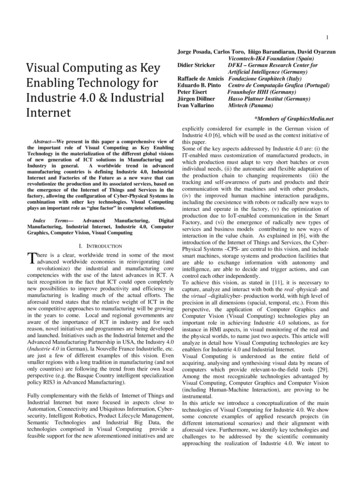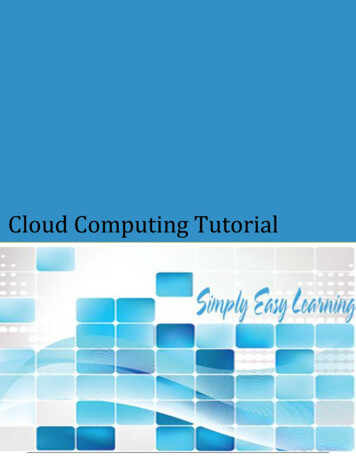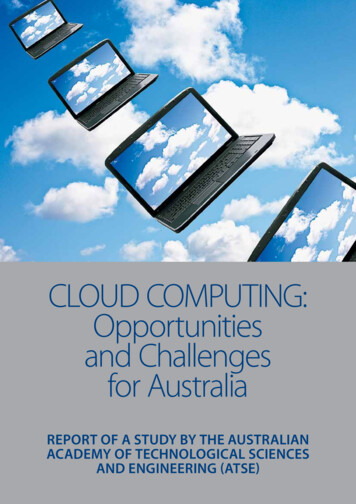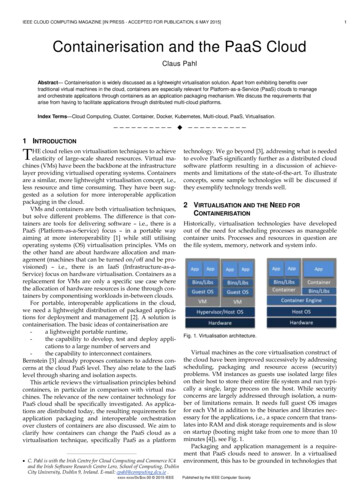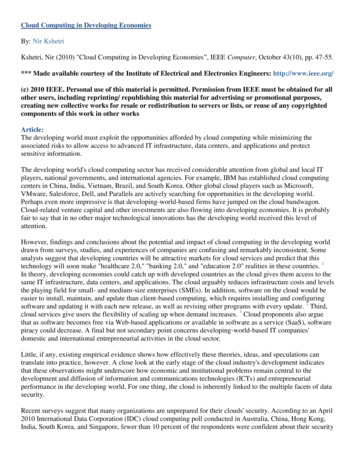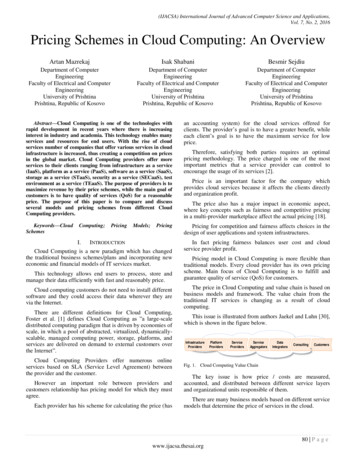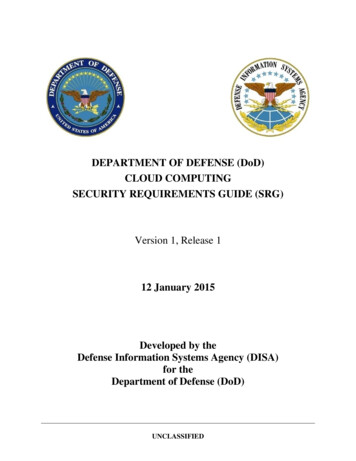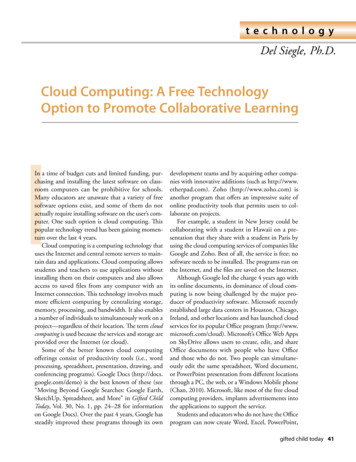
Transcription
technologyDel Siegle, Ph.D.Cloud Computing: A Free Technologyoption to Promote Collaborative learningIIn a time of budget cuts and limited funding, purchasing and installing the latest software on classroom computers can be prohibitive for schools.Many educators are unaware that a variety of freesoftware options exist, and some of them do notactually require installing software on the user’s computer. One such option is cloud computing. Thispopular technology trend has been gaining momentum over the last 4 years.Cloud computing is a computing technology thatuses the Internet and central remote servers to maintain data and applications. Cloud computing allowsstudents and teachers to use applications withoutinstalling them on their computers and also allowsaccess to saved files from any computer with anInternet connection. This technology involves muchmore efficient computing by centralizing storage,memory, processing, and bandwidth. It also enablesa number of individuals to simultaneously work on aproject—regardless of their location. The term cloudcomputing is used because the services and storage areprovided over the Internet (or cloud).Some of the better known cloud computingofferings consist of productivity tools (i.e., wordprocessing, spreadsheet, presentation, drawing, andconferencing programs). Google Docs (http://docs.google.com/demo) is the best known of these (see“Moving Beyond Google Searches: Google Earth,SketchUp, Spreadsheet, and More” in Gifted ChildToday, Vol. 30, No. 1, pp. 24–28 for informationon Google Docs). Over the past 4 years, Google hassteadily improved these programs through its owndevelopment teams and by acquiring other companies with innovative additions (such as http://www.etherpad.com). Zoho (http://www.zoho.com) isanother program that offers an impressive suite ofonline productivity tools that permits users to collaborate on projects.For example, a student in New Jersey could becollaborating with a student in Hawaii on a presentation that they share with a student in Paris byusing the cloud computing services of companies likeGoogle and Zoho. Best of all, the service is free; nosoftware needs to be installed. The programs run onthe Internet, and the files are saved on the Internet.Although Google led the charge 4 years ago withits online documents, its dominance of cloud computing is now being challenged by the major producer of productivity software. Microsoft recentlyestablished large data centers in Houston, Chicago,Ireland, and other locations and has launched cloudservices for its popular Office program (http://www.microsoft.com/cloud). Microsoft’s Office Web Appson SkyDrive allows users to create, edit, and shareOffice documents with people who have Officeand those who do not. Two people can simultaneously edit the same spreadsheet, Word document,or PowerPoint presentation from different locationsthrough a PC, the web, or a Windows Mobile phone(Chan, 2010). Microsoft, like most of the free cloudcomputing providers, implants advertisements intothe applications to support the service.Students and educators who do not have the Officeprogram can now create Word, Excel, PowerPoint,gifted child today 41
Cloud ComputingFigure 1. Microsoft has joined the cloud computingmovement with free web-based versions of itspopular Office Suite.and OneNote documents on WindowsLive (http://www.windowslive.com).Users must have a Windows Livelogin. With it, they can freely create,edit, save, and share documents without installing any software. After logging into Windows Live, students canaccess files they have saved or createnew files from the Office tab at the topof the page (see Figure 1). And conveniently, like in Google Docs and Zoho,the documents they create are availablefor editing and sharing from any computer connected to the Internet.There are four major advantages tocloud computing. First, multiple copies of software applications do not needto be installed on computers aroundthe school. This saves time and thecost of site licenses. Second, althoughdocuments created with these applications can be downloaded to the user’scomputer, they are usually saved on thesoftware provider’s server, so they canbe accessed from any computer connected to the Internet. Third, in manycases, the creator of a document caninvite others to view and even edit thedocument. Several people in differentlocations can be interacting simulta42 fall 2010 vol 33, no 4Figure 2. Young students can easily make simpleimprovements to their digital images with Picnik.neously with a single document. Thiseliminates the need for multiple versions of the same document—thecurrent version is the latest version.Finally, in many cases, each versionof the document is saved and previous versions of a document can easilybe retrieved. Some cloud computingoptions contain all of these features,while others contain one or two ofthem.Businesses are finding that cloudcomputing saves time and money, andschools will also find cloud computingto not only be “budget friendly,” buteducationally beneficial. Students canlearn a variety of computer productionskills in a collaborative learning environment. Projects started at school canbe continued at home without havingto transfer files or download compatible software.In the not too distant future, it isconceivable that cloud computing maybe the standard platform for all software, and users will pay a monthly oryearly fee for using the services. Severalsoftware providers have already movedto this business model. Although feeservices already exist, all of the pro-grams shared in this column are free.Some of these options are filled withadvertising, others are not. Somerequire a user login and password(essential for storing and retrievingfiles), although many do not.In addition to the popular productivity tools provided by Google, Zoho,and Microsoft, new specialty softwarehas surfaced that features some ofthe cloud computing componentsdescribed above, but not necessarilyall of them. Educators will find several of these programs very useful. Theremainder of this column is dedicatedto sharing a few of them.Photo EditingDigital recording devices havebecome ubiquitous. In addition tothe widespread availability of digitalcameras, digital recording devices arenow built into most computers andcell phones. The images from manyof these devices can be improved andenhanced with photo editing software.Increasingly, in this digital age, ideasare being expressed visually. Being ableto express oneself visually is becoming
Cloud Computinga useful communication tool. Studentsenjoy taking and editing digital photographs. They also can learn to improvethe images they use in the presentation they make and the productsthey create. Whereas Google’s Picasa(http://picasa.google.com) is a popularand free photo editing software thatcan be downloaded and installed onusers’ computers, Picnik (http://www.picnik.com), Splashup (http://www.splashup.com), and Pixlr (http://www.pixlr.com) are three cloud computingonline applications that will meetmost students’ image-editing needsand run on the Internet without beingdownloaded and installed. Beginnerswill enjoy the easy-to-use features ofPicnik, while more advanced userscan appreciate the more sophisticatedfeatures found in Splashup and Pixlr.Although each of these programs runsthrough the Internet without installing additional software, they do nottechnically meet the full definitionof cloud computing for two reasons.First, only one person can retouch animage at a time. The programs lack thecollaborative feature of cloud computing. Second, the images are stored onthe user’s computer, rather than ona remove server (although there areoptions to store and share the finalimage on the Internet). With these twodrawbacks in mind, they are still usefulprograms that educators and parentswill want to consider.Picnik (which was recently acquiredby Google) can be used without creating a login and password, althoughusers will need one to create slideshows that can be shared on theInternet. Picnik also has a wide rangeof advanced features that are blockedon the free version. With little to noinstruction, students should be able toaccess the program, upload a digitalimage from their computer, and applya variety of editing functions. Theopening screenoffers options toupload a photo forretouching, createcollages, print animage, or createslide shows thatcan be posted onthe Internet.Once a photois uploaded, it caneasily be improvedwithin the Edittab (see Figure2). Students cancrop, improve thecolor, remove redeye, and sharpentheir images.Students can savetheir retouchedimages back totheir computerwith the Save &Share tab. TheCreate tab contains a number ofadvanced featuresthat are mostlyrestricted to theFigure 3. Students can create a variety of collagespremium ( 24.95of their favorite images with Picnik.per year) version.The Library taband advanced features are restricted topermits studentsto upload up to five photos, provided the premium version.More advanced users are probablythey have established a login and passfamiliarwith Adobe’s Photoshop,word. The premium version permitsmore photos to be saved on the site. which has been an industry standardStudents also can design and save col- for photo retouching. One key featurelages (see Figure 3) of their photos. If of Photoshop is the ability to createstudents have a login and password, layers. With layers, parts of severalthey can create automated slide pre- images can be combined to create newsentations that can be posted to the images. For example, the backgroundInternet. The advantage of Picnik is of one image can be erased and thethat it is user-friendly and easy to use. image can then be placed on a differUnfortunately, many of the interesting ent background. Splashup and Pixlrgifted child today 43
Cloud ComputingFigure 4. The Tools, layers, and History windows of Pixlr resemble those ofPhotoshop.have the layers option. Pixlr does notrequire a login or password and alsoincludes many of the features usershave come to expect from AdobePhotoshop. Students can create a newimage from a blank screen using thedrawing tools of Pixlr, open an imagefrom their computer, or open an imagefrom the Internet.Once an image has been opened inPixlr, a set of Tools appears to the leftof the image and History and Layerswindows appear to the right of theimage (see Figure 4). These resemblethe windows featured in Photoshop,and Photoshop users will feel right athome with this program.Pixlr has tools to darken (burn),lighten (dodge), smudge, and stretchor squeeze certain areas of an image. Italso features a variety of useful filters.For example, with a simple selectionof the vignette filter, a vignette effectcan be added to a photo (see Figure 5).Images can be saved to the user’s computer or saved to the web for othersto view. Pixlr creates a unique addressfor the shared photos. Users can sharethat address with others; however, anyone who has access to the address candelete the image.DropboxFigure 5. A variety of filters, including the vignette effect, areavailable with Pixlr.44 fall 2010 vol 33, no 4Cloud computing may be multiplepeople collaborating on documents inreal time across the Internet, such asGoogle Docs, Zoho, and WindowsLive Office. It may be a web-basedsoftware program that eliminates theneed to install the software on the user’scomputer, such as in Picnik, Splashup,and Pixlr. Or, it may be simply storingdocuments in the clouds, on remotecomputers connected to the Internet.Nothing is more frustrating thanhaving to transfer files between acomputer at work or school and one
Cloud Computingat home. Cloud computing can easily eliminate this frustration; http://www.dropbox.com provides an elegantsolution to this problem. Dropbox isa program that users install on eachof their computers. The program creates a folder on each computer calledMy Dropbox. Any file that is savedto or copied to that folder will automatically appear on each of the user’scomputers that has Dropbox installed.For example, I began this article onmy office computer. I saved the file inMy Dropbox folder on my office computer. Over the weekend, I opened thethe My Dropbox folder on my laptopand continued working on this manuscript. I saved my work on the laptopin the My Dropbox folder and, onMonday when I returned to the office,opened that latest version of the file onmy office computer and continued towork on the document.Dropbox eliminates the need tomove files from one computer toanother. The Dropbox software linksall of a user’s computers together viaa single folder. It also allows users toshare folders with colleagues on othercomputers. Transferring data betweencomputers traditionally requiresuploading via web forms, connectingto network drives, carrying aroundthumb drives, or sending e-mails withattachments to others and oneself.Dropbox makes all of these methodsobsolete. The service is free for storageup to 2 GB. The company charges amonthly fee if users wish to store more.Dropbox uses the Internet to synchronize the content on the users’computers. The actual files are savedon each of the computers in the MyDropbox folder, so users do not needto be connected to the Internet toaccess their files. They can open, edit,and save files without Internet access.Once the computer is connected to theInternet, it automatically uploads theupdated or new file for download tothe user’s others computers. Users alsocan access their files from any computer connected to the Internet byvisiting the Dropbox website.In SummaryThe world of cloud computing ischanging daily. Companies that existat the writing of this column may beacquired by others by the time thispiece is printed, and new companieswill have surfaced. The only certaintyis that cloud computing has made itsmark and will continue to becomemore popular. Laptop manufacturers have taken notice and a varietyof Netbooks for under 300 are nowavailable. Programs running on theInternet cloud do not required extensive memory or storage capacity on thecomputer using them; thus, manufacturers have been able to cut laptop costsby building them with slower processors, less memory, and less storage.These new Netbooks bring educatorscloser to the day when each studentwill have a computer and the Internetat his or her fingertips. Educators needto embrace this trend in technologyas they develop students’ talents andexpand their students’ understandingof a world that lies in wait at their fingertips. GCTReferenceChan, S. P. (2010, May 8). Big leap:Microsoft makes free version ofOffice, its cash cow. The SeattleTimes. Retrieved from nology/2011818423microsoftoffice09.html?prmid related stories sectionnew fromprufrockpressWhen parentsneed the mostauthoritativeinformation onraising giftedkids, they canturn to ParentingGiftedChildren: TheAuthoritativeGuide From theNational Association for Gifted Children.This comprehensive guide covers topicssuch as working with high achieversand young gifted children, acceleration,advocating for talented students, servingas role models and mentors for giftedkids, homeschooling, underachievement,twice-exceptional students, andpostsecondary opportunities. The onlybook of its kind, this guidebook willallow parents to find the support andresources they need to help their childrenfind success in school and beyond.Parenting GiftedChildren: TheAuthoritative Guidefrom the NationalAssociation forGifted Children978-1-59363430-8 21.95 US/ 25.95 CAN592 pages6" 9"To order, please visitour website at http://www.prufrock.com orcall 800.998.2208gifted child today 45
puter. One such option is cloud computing. This popular technology trend has been gaining momen-tum over the last 4 years. Cloud computing is a computing technology that uses the Internet and central remote servers to main-tain data and applications. Cloud computing
